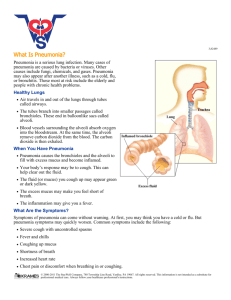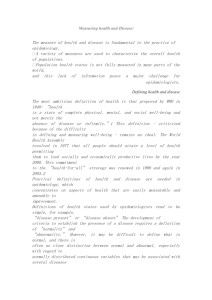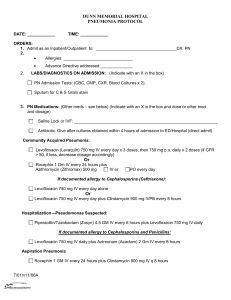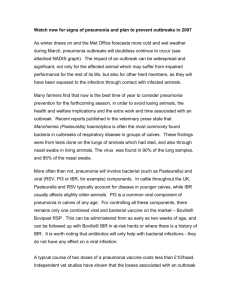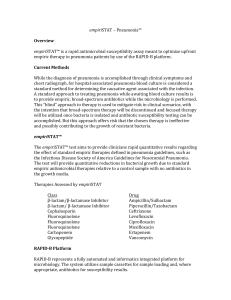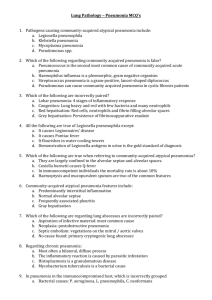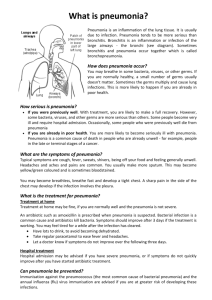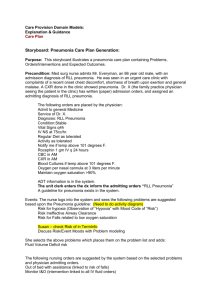Case Study
advertisement
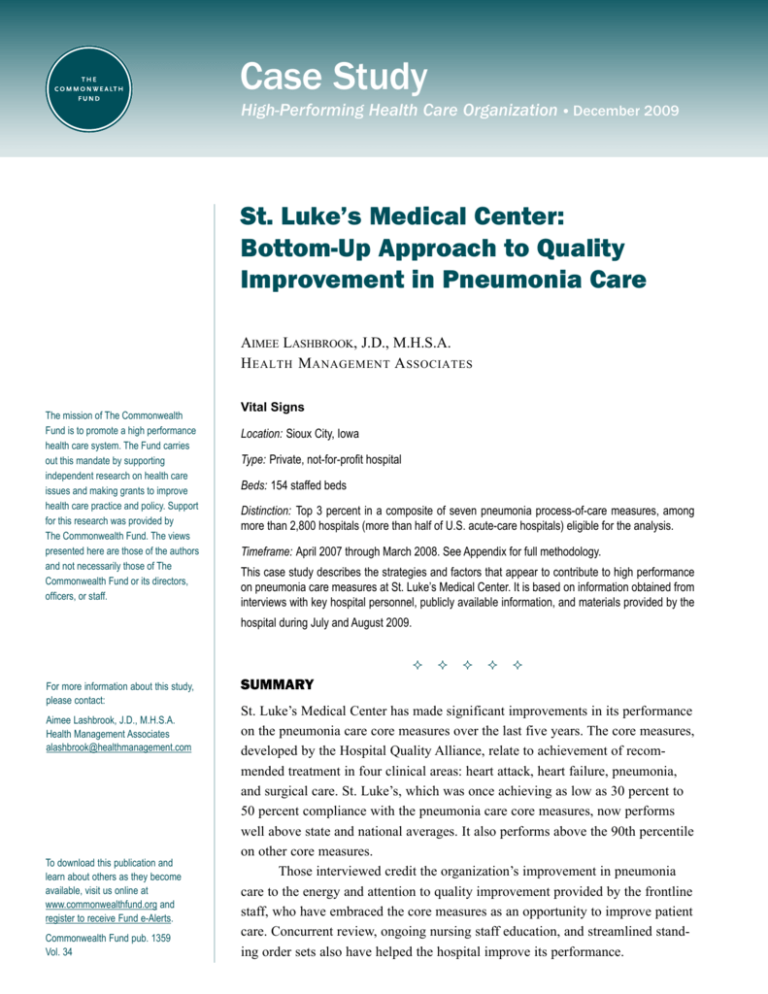
Case Study High-Performing Health Care Organization • March 2009 December 2009 St. Luke’s Medical Center: Bottom-Up Approach to Quality Improvement in Pneumonia Care Aimee Lashbrook, J.D., M.H.S.A. H ealth M anagement A ssociates The mission of The Commonwealth Fund is to promote a high performance health care system. The Fund carries out this mandate by supporting independent research on health care issues and making grants to improve health care practice and policy. Support for this research was provided by The Commonwealth Fund. The views presented here are those of the authors and not necessarily those of The Commonwealth Fund or its directors, officers, or staff. Vital Signs Location: Sioux City, Iowa Type: Private, not-for-profit hospital Beds: 154 staffed beds Distinction: Top 3 percent in a composite of seven pneumonia process-of-care measures, among more than 2,800 hospitals (more than half of U.S. acute-care hospitals) eligible for the analysis. Timeframe: April 2007 through March 2008. See Appendix for full methodology. This case study describes the strategies and factors that appear to contribute to high performance on pneumonia care measures at St. Luke’s Medical Center. It is based on information obtained from interviews with key hospital personnel, publicly available information, and materials provided by the hospital during July and August 2009. For more information about this study, please contact: Aimee Lashbrook, J.D., M.H.S.A. Health Management Associates alashbrook@healthmanagement.com To download this publication and learn about others as they become available, visit us online at www.commonwealthfund.org and register to receive Fund e-Alerts. Commonwealth Fund pub. 1359 Vol. 34 Summary St. Luke’s Medical Center has made significant improvements in its performance on the pneumonia care core measures over the last five years. The core measures, developed by the Hospital Quality Alliance, relate to achievement of recommended treatment in four clinical areas: heart attack, heart failure, pneumonia, and surgical care. St. Luke’s, which was once achieving as low as 30 percent to 50 percent compliance with the pneumonia care core measures, now performs well above state and national averages. It also performs above the 90th percentile on other core measures. Those interviewed credit the organization’s improvement in pneumonia care to the energy and attention to quality improvement provided by the frontline staff, who have embraced the core measures as an opportunity to improve patient care. Concurrent review, ongoing nursing staff education, and streamlined standing order sets also have helped the hospital improve its performance. 2T he C ommonwealth F und Organization Leadership from the Bottom Up St. Luke’s is located in Sioux City, Iowa, and serves patients in Iowa, Nebraska, and South Dakota. It is one of 26 hospitals that make up the Iowa Health System, an integrated health system in Iowa and western Illinois. It has 154 staffed beds and 286 physicians on its medical staff, and approximately 9,000 inpatient admissions, 77,000 outpatient visits, and 4,700 surgeries each year. Leadership for St. Luke’s core measure performance improvement efforts has come from the bottom up, with frontline physicians and nurses analyzing problems and identifying solutions at the point of care. Deb Colshan, R.N., clinical nurse specialist, believes the engagement of frontline staff has provided the momentum needed to get staff throughout the organization excited about quality improvement. Colshan’s colleagues credit her with providing focused and passionate leadership. Craig Bainbridge, M.D., pulmonologist, says Colshan’s commitment has improved patient outcomes and created a culture of excellence within the organization. Bainbridge believes an organization must have leaders such as Colshan to motivate staff and champion patient care initiatives from start to finish. Hospital-Wide Factors Being part of a larger health system has aided St. Luke’s in its performance improvement efforts. Systemwide collaborative workgroups tackle quality and patient safety matters such as meeting the core measure requirements and avoiding pressure ulcers, stroke sepsis, and patient falls. Typically, a workgroup from each affiliate hospital participates in the collaborative workgroups, through face-to-face meetings as well as teleconferences. A typical quality improvement initiative at St. Luke’s begins with quality improvement staff researching clinical evidence and best practices. It also may include participation in an initiative sponsored by organizations such as the Institute for Healthcare Improvement or the Iowa Foundation for Medical Care, the state’s quality improvement organization. St. Luke’s tests any process change on a small scale before rolling it out across the organization. The hospital reviews its performance data and problemsolves areas in need of improvement. The hospital does not seek to reinvent the wheel, often looking to other hospitals in the Iowa Health System for best practices as well as to external organizations and collaboratives focused on quality improvement. St. Luke’s electronic medical record system includes some built-in alerts and patient care reminders. However, the staff interviewed say it does not play a large role in improving core measure performance, noting that it does not yet have physician order entry capabilities (though St. Luke’s plans to invest in such functionality). Multiple Benefits of Concurrent Review Performance improvement clinicians, nurse managers, and clinical nurse specialists perform concurrent review of medical records for patients with pneumonia as well as other diagnoses. As has been articulated by other hospitals in this pneumonia care series, concurrent review provides an opportunity to mitigate failures and correct noncompliant cases before patients are discharged. When a case falls out of compliance, the physicians and nurses involved are notified. The nurse manager also is made aware of the failure. Every failure triggers a mini root-cause analysis by the quality improvement department and frontline staff. Since it can be difficult to schedule formal meetings, Colshan and frontline staff meet informally to talk about the failure and possible solutions. Kathy Collins, R.N., B.S.N., performance improvement director, appreciates the educational opportunities afforded by concurrent review. When a case falls out of compliance, quality improvement staff use it as an opportunity to educate staff and develop strategies for improvement, such as introducing new alerts in the electronic medical record system. Collins finds this “real-time” education to be very effective in changing behaviors. P arkview M edical C enter : U nderscoring the I mportance Nurse Education In addition to the one-on-one educational opportunities provided when concurrent review uncovers a noncompliant case, quality improvement staff dedicate many hours to educating clinical staff about the core measures and their relationship to improved patient care. Most efforts are targeted at nurses. Posters and other educational materials are placed throughout the hospital. An introduction to the core measures is provided in nursing orientation sessions and personnel meetings. Web-based training opportunities are also available. Whatever the measure, quality improvement staff make sure to explain “the why” behind “the what.” Repetition is also key, says Colshan. Through concurrent review and other educational opportunities, the core measure standards have now become “second nature” to St. Luke’s nurses. Using Data to Motivate Change Public reporting of the core measures motivates staff, as they want to achieve 100 percent compliance. It also has captured the attention of upper management and the hospital board. Managers support the frontline staff by ensuring they have time to devote to quality improvement efforts. The board becomes involved when there is a problem, such as a negative trend in core measure performance, and inquires about the hospital’s plans to address it. Performance results are shared with physicians at all medical staff meetings. The hospital asks for physicians’ input on how to continue to improve as an organization, and they have helped identify barriers and possible solutions. Physician Engagement According to Collins, engaging physicians has been key to the success of St. Luke’s improvement efforts. “Many of our early efforts centered around having a physician champion lead the way and get the other physicians on board,” she says. Physician champions have helped develop order sets and provided direction on the best ways to present change to the medical staff. Although physician champions are not expected of C ommunication in P neumonia C are 3 to participate in all meetings, they are kept informed of the improvements being made and alerted when their help is needed. “We have worked hard at getting past the fear of ‘cookbook medicine,’” says Collins. “We want to ensure that our physicians understand that the changes are evidence-based and that by process improvement we in turn make it easier for them to practice excellent medicine.” Pneumonia Care Improvement Strategies Updating Standing Order Sets In the past five years, St. Luke’s has been working on standardizing disease-specific order sets. The hospital relies on a recognized provider of clinical decisionsupport tools to ensure its order sets are up to date with the most current evidence-based medicine. St. Luke’s experienced pushback from the medical staff when the pneumonia order set was introduced. According to Bainbridge, “the hospital’s first order set for pneumonia was long and included everything under the sun.” Physicians were not accustomed to using order sets and were reluctant to incorporate them into their routines because they were too cumbersome. “There was a real need to make the order sets easier to use, more convenient, and more accessible,” he says. The team of quality improvement staff and frontline nurses sought feedback from physician champions and removed extraneous information from the order set. They also brought in an infectious disease specialist to validate the recommendations, which are largely based on the infectious disease society’s guidelines. The pneumonia order set includes both physician and nursing orders. Some orders, such as smoking cessation counseling, vaccination screening, and blood culture prior to antibiotic administration, are standing orders and must be initiated unless the physician draws a line through the order. The order set also includes a list of recommended antibiotics for pneumonia patients, which have proven particularly helpful for physicians who do not routinely treat pneumonia 4T he C ommonwealth F und Exhibit 1. St. Luke’s Medical Center Scores on Pneumonia Care Core Measures Compared with State and National Averages National Average Iowa Average St. Luke’s Regional Medical Center Percent of pneumonia patients given oxygenation assessment 99% 99% 100% of 291 patients Percent of pneumonia patients assessed and given pneumococcal vaccination 83% 88% 97% of 222 patients Percent of pneumonia patients whose initial emergency room blood culture was performed prior to the administration of the first hospital dose of antibiotics 90% 93% 100% of 216 patients Percent of pneumonia patients given smoking cessation advice/counseling 88% 84% 99% of 83 patients Percent of pneumonia patients given initial antibiotic(s) within 6 hours after arrival 93% 94% 100% of 232 patients Percent of pneumonia patients given the most appropriate initial antibiotic(s) 87% 87% 97% of 173 patients Percent of pneumonia patients assessed and given influenza vaccination 79% 84% 96% of 169 patients Pneumonia Care Improvement Indicator Source: www.hospitalcompare.hhs.gov. Data are from July 2007 through June 2008. patients. The order set leaves room for deviations from the core measures when medically appropriate. Since its introduction, the pneumonia order set has been revised on more than one occasion; as it has been streamlined and become easier to use, physicians have increasingly used it. When it was instituted, quality department staff educated nurses about the role of standing orders in improving core measure performance and patient care. They also hung posters encouraging order set use on the walls of the emergency room. Nurses responded by pressing physicians to use the pneumonia order set until it became part of their routines. St. Luke’s intends to build its order sets, including the pneumonia order set, into a computerized physician order entry system. Administration of Antibiotics It took time and effort before St. Luke’s was able to show significant improvement in meeting the core measure standard of antibiotic administration within four hours of arrival (this standard has since been changed to within six hours of arrival). Pneumonia cases can be difficult to diagnose in the emergency department because patients may experience symptoms related to other diseases, such as congestive heart failure, that mimic pneumonia. Physicians do not like proceeding down the pneumonia pathway with “blinders on,” which potentially could cause them to miss the correct diagnosis. When the diagnosis is delayed, it can be difficult to ensure administration of antibiotics within a certain time of arrival. Physicians also do not want to unnecessarily give their patients antibiotics. St. Luke’s has been able to improve the timeliness of antibiotic administration by assigning the emergency room physicians responsibility for ordering the first dose of antibiotics. This saves time when the alternative is waiting for a physician on the floor to which a patient is ultimately admitted to order and administer the antibiotic. Both the pharmacy and the emergency department nurses know that the antibiotic must be filled and administered as soon as the order comes in. Nurses complete a checklist form documenting the time the antibiotic is administered. I mportance of C ommunication Exhibit 2. St. Luke’s Medical Center Pneumococcal Vaccination Performance, 2004–09 20 0 0 Electronic Support Some parts of St. Luke’s electronic medical record system and other systems are hardwired to encourage compliance with the pneumonia care core measures. For example, the pneumonia order set includes a standing order to initiate the vaccination screening. Like other hospitals interviewed in this case study series, all patients, not only those with pneumonia, are screened for vaccination need upon admission. The protocol is built into the electronic nursing record, which locks until a nurse completes the vaccination screening as part of the admission process. For patients who meet the criteria for a vaccination, the vaccination is administered on the second day of their stay. St. Luke’s Pyxis medication system also is programmed to assist with pneumonia care core measure compliance in the emergency department.1 Before dispensing an antibiotic, the system asks if a blood culture was performed. To allow the antibiotic to be given, the clinician must request an order for a blood culture or request assistance. As a further check on the process, phlebotomists mark a “C” on a dryerase board located in the emergency department to indicate which patients have received a blood culture. The Pyxis medication system promotes patient safety and the reduction of medication errors through medication order management, dispensing, and verification processes. See http://www.carefusion.com/products-and-services/ our-focus/end-to-end-medication-mgmt.aspx. Q3 04 Q4 04 Q1 09 Q3 08 Q4 08 Q1 08 Q2 08 Q3 07 Q4 07 Q1 07 Q2 07 Q3 06 Q4 06 Q1 06 Q2 06 Q3 05 Q4 05 Q1 05 Q2 05 Q3 04 Q4 04 Source: St. Luke’s Medical Center, 2009. Q1 09 20 Q3 08 Q4 08 40 Q1 08 Q2 08 40 Q3 07 Q4 07 60 Q1 07 Q2 07 60 Q3 06 Q4 06 80 Q3 05 Q4 05 80 Q1 04 Q2 04 100 Q1 04 Q2 04 5 Antibiotic w/in 4 hrs of arrival Percent 100 1 P neumonia C are Exhibit 3. St. Luke’s Medical Center Timely Antibiotic Administration Performance, 2004–09 Pneumococcal Vaccination Percent in Q1 06 Q2 06 the Q1 05 Q2 05 P arkview M edical C enter : U nderscoring Source: St. Luke’s Medical Center, 2009. Results St. Luke’s outperforms most hospitals in this country on all of the pneumonia care core measures submitted to the Centers for Medicare and Medicaid Services. Exhibit 1 compares St. Luke’s compliance on the pneumonia care core measures with state and national averages. Exhibits 2 and 3 show the trends over time for core measures related to pneumococcal vaccination and timely antibiotic administration. As Exhibit 3 indicates, it took a few years for the hospital to achieve at least 90 percent compliance in the timely administration of antibiotics measure, for reasons discussed above. The greatest gains documented were for the smoking cessation measure, for which performance went from 30 percent to 100 percent compliance (Exhibit 4). The hospital continues to struggle with administration of the appropriate antibiotics for patients in the ICU. St. Luke’s is educating its physicians on the appropriate antibiotic choices in the ICU and reinforcing this education with posters, letters, and other methods. 6T he C ommonwealth F und Challenges and Lessons Learned Hospitals looking to improve their performance on pneumonia care core measures might take the following lessons from St. Luke’s experience: Exhibit 4. St. Luke’s Medical Center Smoking Cessation Advice Performance, 2004–09 Smoking Cessation Advice Percent 100 • Concurrent review reduces the likelihood of a case falling out of compliance and provides an opportunity to educate clinicians—and reinforce messages—at the point of care. • Reminders and alerts can be programmed into existing patient care systems. Collins believes “without a doubt that St. Luke’s continued success with the measures is due to the dedication and teamwork of physicians and nurses working together to provide each patient the best outcome every time.” 0 Q1 09 Q3 08 Q4 08 Q1 08 Q2 08 Q3 07 Q4 07 Q1 07 Q2 07 Q3 06 Q4 06 Rely on a simple, user-friendly order set to increase performance in the pneumonia care core measures. 20 Q1 06 Q2 06 • 40 Q3 05 Q4 05 Look for physician champions and foster physician engagement in quality improvement activities. 60 Q1 05 Q2 05 • 80 Q3 04 Q4 04 Encourage and build momentum for quality improvement from the bottom up—starting with frontline staff. Q1 04 Q2 04 • Source: St. Luke’s Medical Center, 2009. For More Information For further information, contact Kathy Collins, R.N., B.S.N., performance improvement director at CollinKL@stlukes.org. P arkview M edical C enter : U nderscoring the I mportance of C ommunication in P neumonia C are 7 Appendix. Selection Methodology Selection of high-performing hospitals in process-of-care measures for this series of case studies is based on data submitted by hospitals to the Centers for Medicare and Medicaid Services. We use seven measures that are publicly available on the U.S. Department of Health and Human Services’ Hospital Compare Web site, (www.hospitalcompare.hhs.gov). The measures, developed by the Hospital Quality Alliance, relate to practices in pneumonia care. Pneumonia Care Process-of-Care Measures 1. Percent of pneumonia patients given oxygenation assessment 2. Percent of pneumonia patients assessed and given pneumococcal vaccination 3. Percent of pneumonia patients whose initial emergency room blood culture was performed prior to the administration of the first hospital dose of antibiotics 4. Percent of pneumonia patients given smoking cessation advice/counseling 5. Percent of pneumonia patients given initial antibiotic(s) within 6 hours after arrival 6. Percent of pneumonia patients given the most appropriate initial antibiotic(s) 7. Percent of pneumonia patients assessed and given influenza vaccination The analysis uses all-payer data from July 2007 through June 2008. To be included, a hospital must have submitted data for all seven measures (even if data submitted were based on zero cases), with a minimum of 30 cases for at least one measure, over four quarters. The top 3% among 2,887 hospitals eligible for the analysis and with 50 or more beds were considered high performers. In calculating a composite score, no explicit weighting was incorporated, but higher-occurring cases give weight to that measure in the average. Since these are process measures (versus outcome measures), no risk adjustment was applied. Exclusion criteria and other specifications are available at http://www.qualitynet.org/dcs/ContentS erver?cid=1141662756099&pagename=QnetPublic%2FPage%2FQnetTier2&c=Page). While high score on a composite of pneumonia care improvement process-of-care measures was the primary criteria for selection in this series, the hospitals also had to meet the following criteria: at least 50 beds, not a government-owned hospital, not a specialty hospital, ranked within the top half of hospitals in the U.S. in a composite HQA core measure score and in the percentage of patients who gave a rating of 9 or 10 out of 10 when asked how they rate the hospital overall (measured by Hospital Consumer Assessment of Healthcare Providers and Systems, HCAHPS), full accreditation by the Joint Commission; not an outlier in heart attack and/or heart failure mortality; no major recent violations or sanctions; and geographic diversity. A bout the A uthors Aimee Lashbrook, J.D., M.H.S.A., is a senior consultant in Health Management Associates’ Lansing, Mich., office. Ms. Lashbrook has six years of experience working in the health care industry with hospitals, managed care organizations, and state Medicaid programs. She provides ongoing technical assistance to state Medicaid programs, and has played a key role in the development and implementation of new programs and initiatives. Since joining HMA in 2006, she has conducted research on a variety of health care topics. Aimee earned a juris doctor degree at Loyola University Chicago School of Law and a master of health services administration degree at the University of Michigan. A cknowledgments We wish to thank Kathy Collins, R.N., B.S.N., performance improvement director, Craig Bainbridge, M.D., pulmonologist, Forrest Vickers, R.N., and Deb Colshan, R.N., clinical nurse specialist, for generously sharing their time, knowledge, and materials with us. Editorial support was provided by Martha Hostetter. This study was based on publicly available information and self-reported data provided by the case study institution(s). The Commonwealth Fund is not an accreditor of health care organizations or systems, and the inclusion of an institution in the Fund’s case studies series is not an endorsement by the Fund for receipt of health care from the institution. The aim of Commonwealth Fund–sponsored case studies of this type is to identify institutions that have achieved results indicating high performance in a particular area of interest, have undertaken innovations designed to reach higher performance, or exemplify attributes that can foster high performance. The studies are intended to enable other institutions to draw lessons from the studied institutions’ experience that will be helpful in their own efforts to become high performers. It is important to note, however, that even the best-performing organizations may fall short in some areas; doing well in one dimension of quality does not necessarily mean that the same level of quality will be achieved in other dimensions. Similarly, performance may vary from one year to the next. Thus, it is critical to adopt systematic approaches for improving quality and preventing harm to patients and staff.

